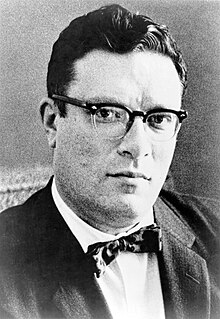The chronoscope
The chronoscope (original title: The Dead Past ) is an approximately 50-page science fiction - short story by Isaac Asimov in 1956, by the history professor Dr. Arnold Potterley acts, who with the help of a young physicist Jonas Foster want to gain access to a chronoscope, a machine with which one can see into the past. With this device Potterley wants to verify his theory about the deity Moloch in Carthage . But both scientists soon realized that chronoscopy harbors completely different dangers.
content
Dr. Arnold Potterley, professor of ancient history, is determined to corroborate his theory that reports of child sacrifice for the deity Moloch in ancient Carthage are based only on propaganda stories from neighboring peoples. His inquiry in this regard to Thaddeus Araman, the chairman of the chronoscopy department of the globally coordinated research, which supposedly already had insights as far back as 3000 BC. Chr. Has authorized, rejected by the latter.
When a young physicist, Jonas Foster, started his work at the university, Potterley got him to find out more about chronoscopy and urged him to build a chronoscope himself. The interest of Foster, who has not yet decided on a research direction, is aroused. With the help of his uncle Ralph Nimmo, a very well-read autodidact without a degree who translates professional research proposals from scientists into understandable texts, Foster learns that it has been practically 20 years since Sterbinski and LaMarr published the basics of neutrinos and chronoscopy and built the first chronoscope , nothing more was published on the subject.
Foster builds a chronoscope in the basement of Potterley's house - Nimmo provides him with the components - using Sterbinski's documents. Potterley seems to be getting closer to his dream of Carthage until he learns from Foster, who tested the device, that chronoscopic observations can only go back about 125 years in practice. Looking further back is not possible because of "the random factors that influence the neutrino flow, what we call the principle of inaccuracy". For this reason, it becomes clear that the information from the Chronoscopy Department , which dates back thousands of years, must be falsified.
Potterley's wife Caroline is still intrigued by it. Their daughter Laurel died in a fire at the age of four about twenty years ago and Caroline hopes to see her child again with a chronoscope. But Arnold Potterley destroys the machine. Allegedly, he doesn't want his wife to be seduced by the chronoscope into living more and more in the past and possibly going insane because Laurel will never come back.
Foster later learned of Potterley's pangs of conscience, because it was possible that a cigarette he had not carefully stubbed out was the cause of the fire in which his daughter Laurel perished. Dr. Potterley's theory and his attempt to wash away the Carthaginians from Moloch's fire sacrifice had a very personal background.
After this change of heart, Dr. Potterley continues to use threats to dissuade Foster from giving the public access to chronoscopy. But even in the event of his death, Foster has already ensured that the truth about chronoscopy and the construction of a chronoscope is passed on to his uncle Ralph Nimmo by securing documents. Thaddeus Araman, who has already confiscated Foster's security deposit, bursts into this discussion. He could do this because he himself was constantly monitoring Foster with a chronoscope. Araman threatens Foster with jail without trial. When his henchmen also arrest Nimmo, Araman reveals the real reason why chronoscopy should not fall into the hands of the public: The distant past is unproblematic. The real problem is the past, which was only a few seconds ago. Everyone could then observe everyone practically permanently with a minimal delay.
Nimmo, who realizes that the Science Commission only wanted to prevent global chaos through its false information, admits that he had rewritten his nephew's scientific text in a more easily understandable manner and had already sent it to several publishers for publication: "I suspect there is no way Put the [atom] mushroom cloud back into the pretty, shiny uranium ball. "Araman then turns to Nimmo, Foster and Potterley:" I congratulate you. Happy goldfish bowl for you, for me and for everyone else, may each of you roast in hell for eternity. "
comment
The short story is one of Asimov's many stories that makes a reference to the powerful Multivac computer system.
Web links
reference
- English: The Dead Past , in The Best of Isaac Asimov , 1954 ?? 1972, Sphere Science Fiction, London (1977), Ed. Angus Wells
- German: Das Chronoskop in Beliebter Roboter (Heyne Science Fiction & Fantasy), No. 3066, Heyne Verlag (1966)
